Table of contents
- PCR
- The collection operations life cycle
- Lockheed’s Martin Cyber Kill Chain
- DevOps Threat Matrix
- Kubernetes Threat Matrix
- Cloud Threat Matrix
- Threat Hunting
- Shodan
- VirusTotal
- ThreatConnect
- MISP
- ChatGPT
- Databases
- Playbook
- Log
- References
Threat Intelligence
Threat intelligence is the process of gathering and analyzing information about potential and existing cybersecurity threats, such as malware, phishing attacks, and data breaches. The goal of threat intelligence is to provide organizations with actionable insights that can help them identify and mitigate potential security risks before they can cause harm.
In the context of DevSecOps, threat intelligence is an important component of a comprehensive security strategy. By gathering and analyzing information about potential security threats, organizations can better understand the security risks that they face and take steps to mitigate them. This can include implementing security controls and countermeasures, such as firewalls, intrusion detection systems, and security information and event management (SIEM) systems, to protect against known threats.
Threat intelligence can also be used to enhance other DevSecOps practices, such as vulnerability management and incident response. By identifying potential vulnerabilities and threats in real-time, security teams can take swift action to remediate issues and prevent security incidents from occurring.
Some of the key benefits of threat intelligence in DevSecOps include:
Improved threat detection: Threat intelligence provides organizations with the information they need to detect potential security threats before they can cause harm.
Better decision-making: By providing actionable insights, threat intelligence helps organizations make informed decisions about their security posture and response to potential threats.
Proactive threat mitigation: Threat intelligence enables organizations to take a proactive approach to threat mitigation, allowing them to stay ahead of emerging threats and reduce their risk of being compromised.
Enhanced incident response: Threat intelligence can be used to enhance incident response, allowing organizations to quickly and effectively respond to security incidents and minimize their impact.
PCR
- Priority: The priority of the Post Collection Request (PCR) should be determined by considering multiple factors and information. It is recommended to establish priority based on a combination of several criteria. One important factor to consider is the customer who is requesting the intelligence. For instance, if the request comes from the Chief Information Security Officer (CISO), it would be considered more significant compared to a request from a senior network engineer. Furthermore, priority can be influenced by the specific industry vertical being focused on. For example, if the request is made by a CTI analyst working for a bank, the collection manager would likely prioritize intelligence collection based on the common threats faced by the banking industry. By taking into account these various factors, the PCR can be assigned the appropriate level of priority.
When determining the priority of intelligence collection, there are several key factors to consider. These include the customer’s requirements, the desired output or outcome of the collection, the timing interval for the request, and the feasibility of carrying out the request with the available collection systems. While there is no one-size-fits-all approach to priority, these considerations play a crucial role in determining the order in which requests are addressed. In later chapters, the topic of priority will be explored further, particularly in relation to surveying the specific needs of an organization and its collection operations.
- Key: The key serves as a distinct identifier that can be utilized in conjunction with other systems for reference and tracking purposes. It can be generated automatically, like a primary key, or combined with unique identifiers to provide additional information about the type or priority of the collection. By examining the expanded key, such as PCR-001-P-BIN-FIN-P1, an organization can easily discern the nature and significance of the collection.
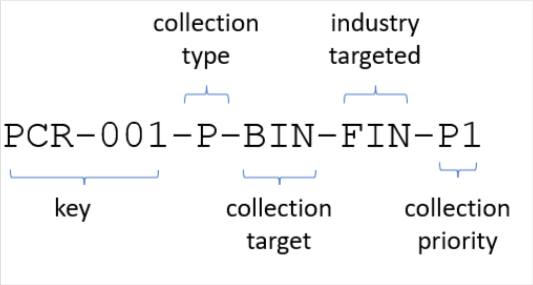
The collection operations life cycle
Effective intelligence-gathering requires careful planning, taking into account established collection priorities, special requests for information (RFIs), and regular administration of collection operations. Proper planning ensures that data is collected in a way that aligns with the organization’s intelligence-gathering needs.

People
To meet the organization’s needs, it is important to have a defined Priority Collection Requirement (PCR) and assess whether the organization has the right personnel to execute the collection. Personnel evaluation in this context can be divided into three categories: technical skills, language proficiency, and subject matter expertise (SME) focus area. These categories help the collection manager determine if the personnel have the necessary qualifications for effective collection.
Technical discipline: In many cases, collection operations can be effectively carried out with the right technical skills, particularly for passive and hybrid collection operations. These types of operations primarily rely on technical expertise to gather information, rather than actively engaging with vetted-access communities or developing sources through direct engagement. The collection manager’s main consideration is to ensure that the personnel assigned to the collection possess the necessary technical skills to acquire the desired data.
Language requirement: Language skills can play a vital role in collection operations for several reasons. Firstly, if the information being collected is in a specific language, having someone who can read and interpret that language is essential to extract the relevant details. Additionally, language skills become necessary when conducting collection efforts in vetted-access communities that primarily communicate in a particular language. Moreover, these skills are crucial when engaging actively with sources or attempting to recruit individuals. If the intelligence gathering requires a regional focus, collection personnel may need to be native speakers with cultural and regional understanding to effectively carry out the operations.
SME focus area: In addition to technical and language skills, the collection manager should also assess whether the collector needs to have subject matter expertise (SME) in a specific threat area. It is common for individuals in the CTI industry to specialize in areas such as ransomware, banking trojans, nation-state threats, or advanced persistent threats (APTs). If a collector possesses specialized expertise in a particular threat area, it is advisable to assign them to the collection operation rather than someone with only general knowledge of that threat type. This ensures that the collection efforts benefit from the in-depth understanding and insights provided by an SME.
Process
Once the collection manager has identified the suitable personnel for a collection operation, they should collaborate with the collection team to develop the operational plan. This involves considering several key factors that are crucial for a successful intelligence gathering. These factors will be discussed in the following sections.
OPSEC: we talked about the The OPSEC (Operations Security) process is of utmost importance and should be ingrained in the culture of the group. During operations planning, the collection manager should go through the OPSEC processes and procedures with the collection team. This ensures that the team understands the significance of OPSEC and prevents them from becoming complacent or feeling overly secure during the execution of the operation. By incorporating OPSEC into the planning phase, the team remains vigilant and maintains a strong focus on protecting sensitive information and maintaining operational security.
Review any current intelligence: During the development of the operations plan, it is important for the collection manager and team to thoroughly review all intelligence holdings related to the desired data and its source. This review provides valuable information about the collection process, the specific environment where the collection will take place, and details about the source of information. By conducting this review, the collection team gains a deeper understanding of the collection requirements and can effectively tailor their approach to ensure successful data acquisition.
Be cognizant of operation branches or sequels: When planning collection operations, it is crucial to consider the history of previous data collection from a specific source location. This history can provide valuable insights into the operations of the collection team and the story it tells. For example, it may reveal patterns such as repeated use of certain IP ranges or VPNs, which could indicate tracking of user information. In more complex scenarios, such as collecting from dark markets or hacking forums, the collection team must carefully assess their history in those locations. They need to consider factors such as existing personas, any incidents that may have compromised their identities, and the potential for setting up multiple collection operations. Understanding the history of collection from a source location is essential for effective operations planning.
Tools and technology
After ensuring the availability of suitable personnel and conducting thorough planning, the collection manager should focus on the technology and infrastructure required for the operations plan. This includes evaluating the necessary collection tools and systems. Collection tools refer to the specific software or hardware used to gather intelligence, while collection systems encompass the broader infrastructure needed to support operational security (OPSEC) and collection requirements. It is essential for the collection manager to assess whether the team has access to the appropriate technologies and infrastructure to effectively carry out the collection activities.
Lockheed’s Martin Cyber Kill Chain
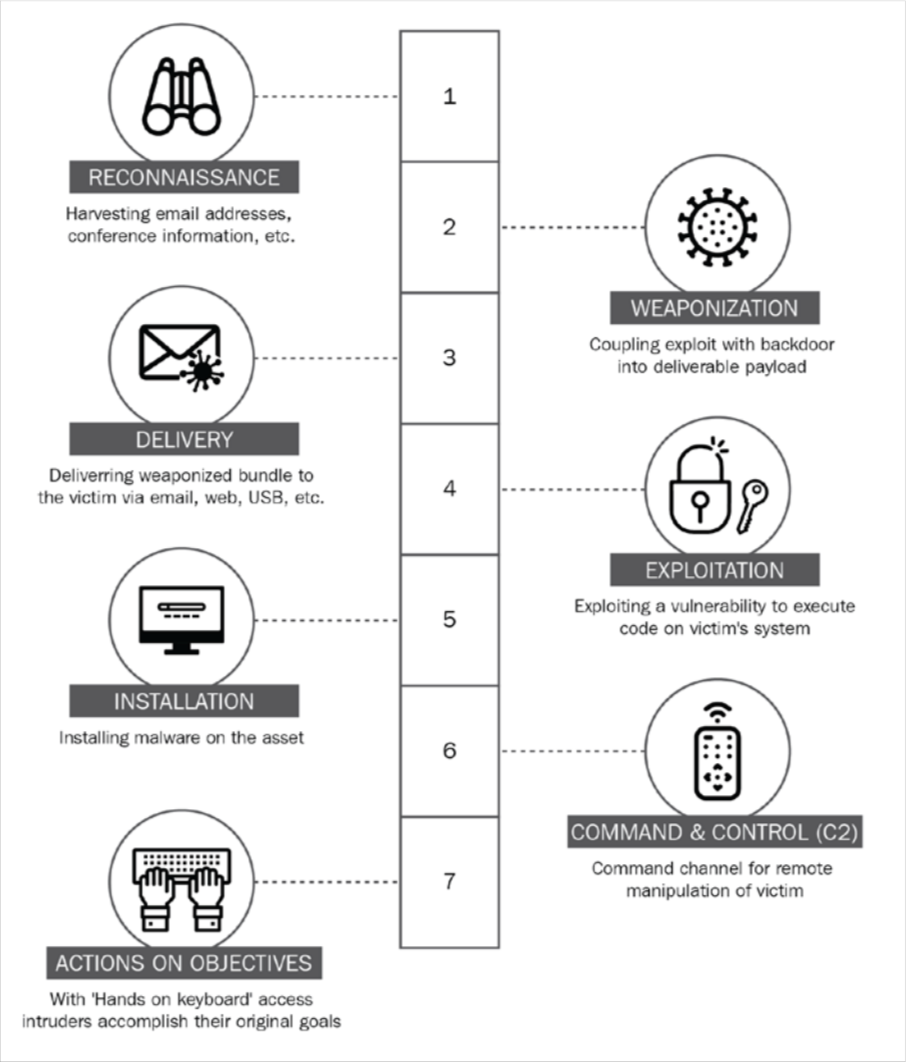
Reconnaissance:
Example: An attacker gathers information about the target organization using publicly available sources, social media, or other reconnaissance techniques.
Cheatsheet commands and tools:
- WHOIS lookup:
whois <target> - DNS enumeration:
nslookup <target> - Google dorking:
site:<target>
- WHOIS lookup:
Weaponization:
Example: The attacker crafts or obtains a malicious payload, such as a malware or exploit, to deliver to the target.
Cheatsheet commands and tools:
- Metasploit Framework:
msfvenom -p <payload> -f <format> -o <output> - Veil-Evasion:
veil-evasion
- Metasploit Framework:
Delivery:
Example: The attacker delivers the weaponized payload to the target through various methods, such as email attachments, compromised websites, or social engineering.
Cheatsheet commands and tools:
- Phishing email generation: GoPhish, SET
- Malicious website hosting: Apache, Nginx
- Exploit kits: Blackhole, Angler
Exploitation:
Example: The attacker takes advantage of vulnerabilities in the target’s system or applications to gain unauthorized access.
Cheatsheet commands and tools:
- Exploitation frameworks: Metasploit, ExploitDB
- Exploit development: Python, Ruby, C/C++
- Web application scanners: Nessus, Nikto
Installation:
Example: The attacker installs backdoors, remote access tools, or other malicious software to establish persistence and maintain control over the compromised system.
Cheatsheet commands and tools:
- Remote administration tools: Netcat, TeamViewer
- Remote access trojans (RATs): DarkComet, Poison Ivy
- Fileless malware: PowerShell, WMI
Command and Control (C2):
Example: The attacker establishes communication channels with the compromised system to remotely control and manage the attack.
Cheatsheet commands and tools:
- C2 frameworks: Cobalt Strike, Metasploit
- Encrypted communication: TOR, SSL/TLS
- DNS-based communication: Dnsmasq, Dnscat2
Actions on Objectives:
Example: The attacker achieves their intended goals, which could include data theft, privilege escalation, further network compromise, or disruption of services.
Cheatsheet commands and tools:
- Data exfiltration: FTP, SCP, Steganography
- Privilege escalation: sudo, PowerSploit
- Network propagation: EternalBlue, WannaCry
Lateral Movement:
Example: The attacker moves laterally within the network, searching for additional targets or systems to compromise.
Cheatsheet commands and tools:
- Network scanning: Nmap, Masscan
- Credential theft: Mimikatz, Responder
- Pass-the-Hash: Psexec, PsExecWrapper
DevOps Threat Matrix
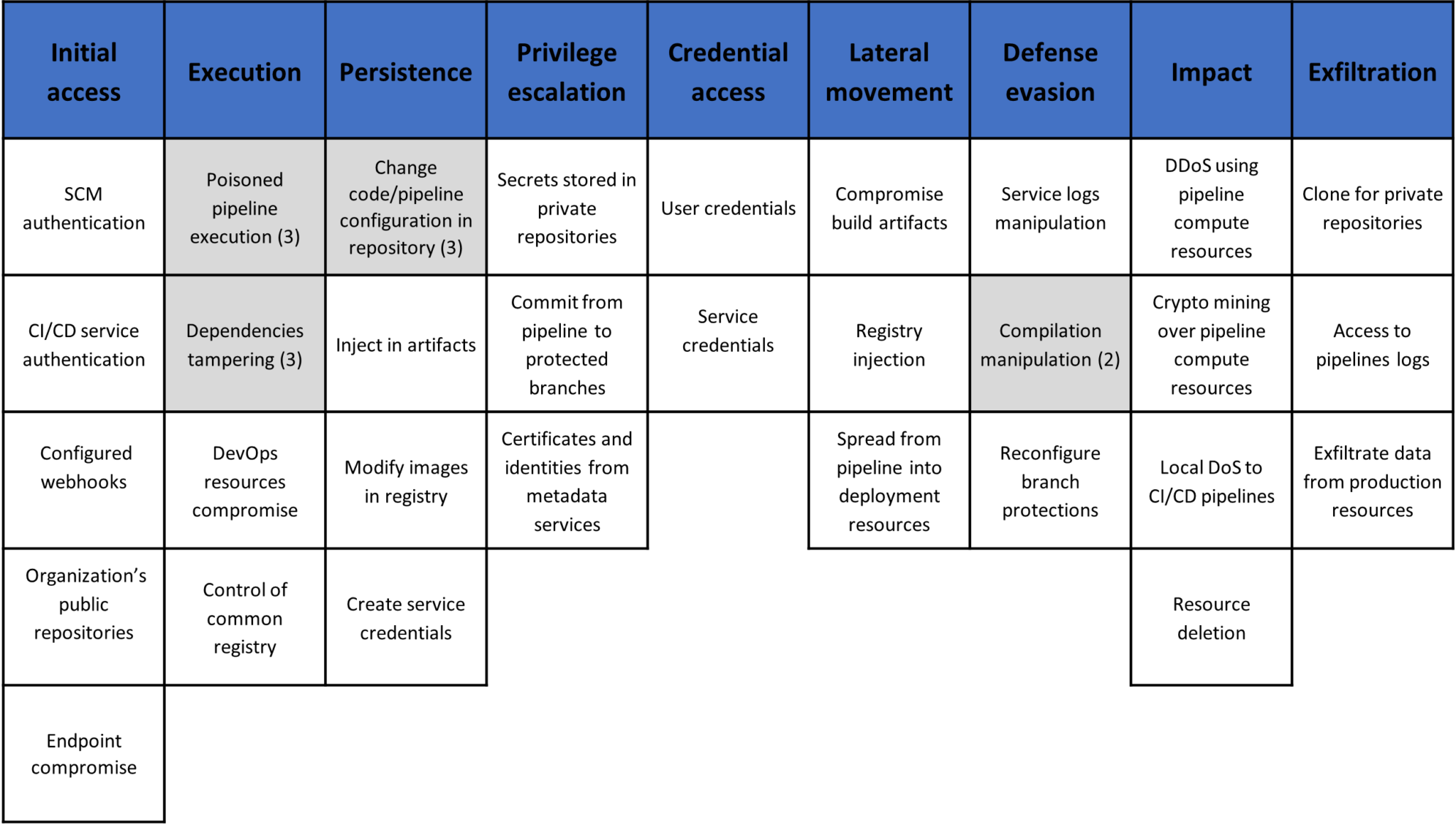
A DevOps Threat Matrix is a comprehensive framework or resource that identifies and categorizes potential security threats and risks associated with implementing DevOps practices. It aims to provide organizations with insights into the security challenges they may encounter while adopting a DevOps approach and offers guidance on mitigating these risks.
The Microsoft Security Blog, which you mentioned, likely provides detailed information on their DevOps Threat Matrix. It may cover different threat categories such as:
Insider Threats: This includes potential risks arising from employees or individuals with authorized access to systems, data, or infrastructure.
External Attacks: These are threats posed by external entities, such as hackers, who attempt to exploit vulnerabilities in the DevOps environment.
Data Loss and Leakage: This category encompasses risks related to the unauthorized disclosure or loss of sensitive information during the DevOps pipeline.
Supply Chain Attacks: These threats involve compromising the software supply chain, targeting third-party libraries, dependencies, or build processes.
Infrastructure Vulnerabilities: This focuses on weaknesses within the infrastructure components of the DevOps environment, such as misconfigurations or insecure cloud services.
Compliance and Regulatory Risks: DevOps practices need to align with industry standards and regulatory requirements. Failure to comply may lead to legal and financial consequences.
The DevOps Threat Matrix is likely to provide organizations with actionable recommendations, best practices, and security controls that can be implemented at various stages of the DevOps lifecycle. This could include secure coding practices, continuous monitoring, vulnerability scanning, access controls, and incident response procedures.
Initial access
In the context of the DevOps Threat Matrix, “Initial Access” refers to a category of threats that focus on unauthorized entry points or mechanisms through which an attacker gains initial access to a system or network. It involves the exploitation of vulnerabilities or weaknesses in the DevOps infrastructure, applications, or processes to establish a foothold for further malicious activities.
SCM authentication
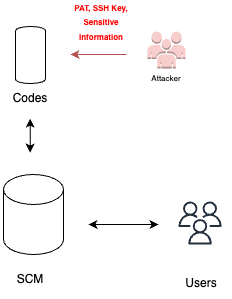
SCM authentication refers to the process of authenticating and accessing an organization’s source code management (SCM) system. It typically involves using authentication methods such as personal access tokens (PATs), SSH keys, or other allowed credentials. However, attackers may attempt to exploit this authentication process, gaining unauthorized access to the SCM by employing techniques like phishing attacks. This can pose a significant threat to the organization’s source code and sensitive information. To mitigate this risk, it’s crucial to be aware of potential attacks and implement robust security measures.
CI/CD service authentication
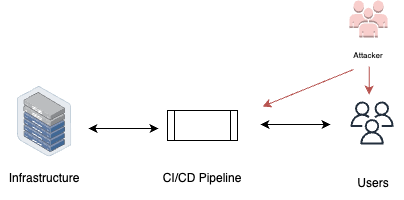
CI/CD service authentication refers to the process of authenticating and accessing the Continuous Integration/Continuous Deployment (CI/CD) service used by an organization for automating software delivery pipelines. Attackers may attempt to exploit vulnerabilities in the authentication process to gain unauthorized access to the CI/CD service, which can lead to potential compromises in the organization’s DevOps environment. To mitigate this risk, it is important to employ strong authentication methods and implement security measures to protect the CI/CD service from unauthorized access.
Organization’s public repositories
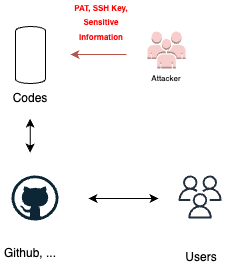
Access to an organization’s public repositories with CI/CD capabilities can pose a security risk if not properly secured. Attackers may attempt to gain unauthorized access to these repositories and exploit their CI/CD capabilities to execute malicious code or disrupt the organization’s pipelines. To mitigate this risk, organizations should implement strong access controls, monitor repository activity, and ensure secure CI/CD configurations.
Endpoint compromise
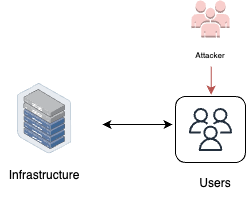
Endpoint compromise refers to a scenario where an attacker gains access to an organization’s resources by compromising a developer’s workstation or endpoint device. Once an endpoint is compromised, the attacker can leverage the compromised workstation to gain unauthorized access to the organization’s source code management (SCM), registry, or other critical resources. To mitigate this risk, organizations should implement strong endpoint security measures and follow best practices for securing developer workstations.
Configured webhooks
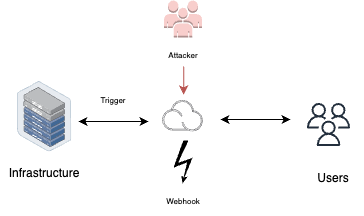
Configured webhooks can become a potential security risk if not properly secured. Attackers can exploit these webhooks to gain initial access to an organization’s network. By triggering requests through the source code management (SCM) system, attackers can potentially gain unauthorized access to services that should not be publicly exposed or might be running outdated and vulnerable software versions within the organization’s private network. To mitigate this risk, organizations should implement secure webhook configurations, monitor webhook activity, and apply necessary access controls.
Execution
The execution tactic in the DevOps Threat Matrix refers to the methods used by attackers to gain execution access on pipeline resources, including the pipeline itself or the deployment resources. Attackers may exploit vulnerabilities or employ various techniques to gain unauthorized control over these resources. Understanding these techniques and implementing appropriate security measures is crucial for mitigating the risk of unauthorized execution and maintaining the integrity of the DevOps pipeline.
Poisoned pipeline execution (PPE)

Poisoned pipeline execution (PPE) is a technique employed by attackers to inject malicious code into an organization’s repository, allowing them to execute unauthorized actions within the repository’s CI/CD system. This technique poses a significant threat as it can lead to the execution of malicious code during the CI/CD process, compromising the integrity of the pipeline and potentially allowing further unauthorized access. Understanding and mitigating the risks associated with poisoned pipeline execution is crucial to maintain the security of the CI/CD system.
Direct PPE (d-PPE)
Direct Poisoned Pipeline Execution (d-PPE) is a technique used by attackers to directly modify the configuration file inside a repository. By injecting malicious commands into the configuration file, the attacker can execute those commands during the pipeline run, potentially compromising the integrity of the pipeline and the associated resources. Mitigating the risk of d-PPE requires implementing secure practices, ensuring strict access controls, and performing thorough validation of configuration files.
Indirect PPE (i-PPE)
Indirect Poisoned Pipeline Execution (i-PPE) is a technique employed by attackers when they cannot directly modify configuration files or when these changes are not considered during pipeline execution. In such cases, attackers target scripts used by the pipeline, such as make-files, test scripts, build scripts, or other similar files, to inject malicious code. By infecting these scripts, the attacker can execute unauthorized code during the pipeline run, potentially compromising the pipeline and associated resources. To mitigate the risk of i-PPE, it is important to implement secure practices, conduct thorough code reviews, and ensure the integrity of pipeline scripts.
Public PPE
Public Poisoned Pipeline Execution (Public PPE) refers to scenarios where the pipeline is triggered by an open-source project. In such cases, attackers can exploit the pipeline by employing techniques like Direct Poisoned Pipeline Execution (d-PPE) or Indirect Poisoned Pipeline Execution (i-PPE) on the public repository. By infecting the pipeline in the open-source project, the attacker can execute unauthorized code during the pipeline run, potentially compromising the integrity of the pipeline and the resources it interacts with. To mitigate the risk of Public PPE, it is essential to implement secure practices, conduct thorough code reviews, and monitor the pipeline execution.
Dependency tampering
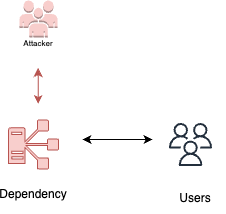
Dependency tampering is a technique used by attackers to execute malicious code in the DevOps or production environment by injecting harmful code into a repository’s dependencies. When these dependencies are downloaded and integrated into the system, the malicious code gets executed, potentially leading to unauthorized access or compromising the integrity of the environment. Preventing and mitigating the risk of dependency tampering requires implementing secure practices, regularly auditing dependencies, and ensuring their integrity.
Public dependency confusion
Public dependency confusion is a technique employed by attackers where they publish malicious packages with the same name as private packages in public registries. When package-control mechanisms search for packages, they often prioritize public registries, making it possible for the malicious package to be downloaded instead of the intended private package. This technique can lead to the execution of malicious code in the DevOps environment or production environment. Preventing and mitigating the risk of public dependency confusion requires implementing secure practices, verifying package sources, and prioritizing trusted registries.
Public package hijack (“repo-jacking”)
Public package hijacking, also known as “repo-jacking,” involves attackers gaining control of a public package by compromising the maintainer account. This technique can occur when attackers exploit vulnerabilities or weaknesses in the package maintainers’ accounts, such as through the exploitation of GitHub’s user rename feature. Once in control, attackers can modify the package’s code, inject malicious code, or redirect users to malicious resources. Mitigating the risk of public package hijacking requires implementing security measures, regularly monitoring package repositories, and ensuring the integrity of maintainers’ accounts.
Typosquatting
Typosquatting is a technique employed by attackers where they publish malicious packages with names similar to well-known public packages. By creating these deceptive package names, attackers aim to confuse users into inadvertently downloading the malicious packages instead of the intended ones. This technique can lead to the execution of unauthorized or malicious code in the DevOps environment or production environment. Preventing and mitigating the risk of typosquatting requires implementing secure practices, verifying package sources, and educating users about potential risks.
DevOps resources compromise

DevOps resources compromise refers to scenarios where attackers target the compute resources used for executing CI/CD agents and other software within the pipeline. By exploiting vulnerabilities in the operating system, agent code, or other software installed on the virtual machines (VMs) or network devices, attackers can gain unauthorized access to the pipeline. This compromise can lead to the execution of unauthorized code, data theft, or disruption of the CI/CD process. To mitigate the risk of DevOps resources compromise, it is crucial to implement security measures, regularly update and patch software, and monitor the infrastructure for suspicious activities.
Control of common registry
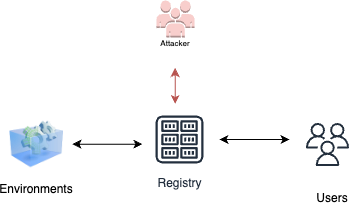
Control of a common registry refers to a situation where an attacker gains control over a registry used by the organization, allowing them to introduce and execute malicious images or packages within the CI/CD pipeline or production environment. This compromise can lead to the execution of unauthorized or malicious code, data breaches, or disruption of the CI/CD process. Protecting against the control of a common registry requires implementing robust security measures, controlling access to the registry, and monitoring for any suspicious or unauthorized activities.
Persistence
The persistency tactic in the context of DevOps threat matrix refers to techniques employed by attackers to maintain access to a victim’s environment even after initial compromise. These techniques allow attackers to persistently control and access the compromised systems, potentially leading to further unauthorized activities, data breaches, or system disruptions. Mitigating the risk of persistency requires implementing strong security practices, conducting regular system audits, and promptly addressing any identified vulnerabilities or unauthorized access.
Changes in repository

Changes in repository refer to techniques where adversaries exploit the automatic tokens within the CI/CD pipeline to access and push code changes to the repository. By leveraging these tokens, which often have sufficient permissions, attackers can achieve persistency within the environment. This persistence can enable unauthorized code modifications, data exfiltration, or further exploitation of the organization’s systems. Preventing and mitigating the risk of changes in the repository requires implementing secure practices, controlling access to tokens, and monitoring repository activities for any suspicious or unauthorized changes.
Change/add scripts in code – we can change some of the initialization scripts/add new scripts, so they download a backdoor/starter for the attacker, so each time the pipeline is executing these scripts, the attacker’s code will be executed too.
Change the pipeline configuration – we can add new steps in the pipeline to download an attacker-controlled script to the pipeline before continuing with the build process.
Change the configuration for dependencies locations – to use attacker-controlled packages.
Inject in Artifacts
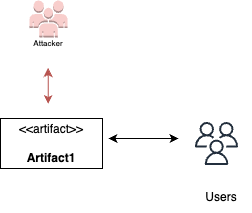
Injecting code into artifacts involves exploiting the functionality of Continuous Integration (CI) environments that allow the creation and sharing of artifacts between pipeline executions. Attackers can manipulate these artifacts to inject malicious code or files, which can lead to unauthorized code execution or compromise of the CI/CD pipeline. Preventing and mitigating the risk of artifact injection requires implementing security measures, validating artifacts, and monitoring for any suspicious or unauthorized changes.
Modify images in registry
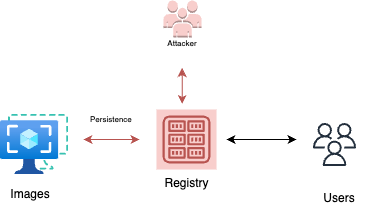
Modifying images in the registry refers to a technique where an attacker gains access to the image registry used by CI/CD pipelines and manipulates the images stored in the registry. By modifying or planting malicious images, the attacker can ensure that these images are executed by the user’s containers, leading to the execution of unauthorized or malicious code within the production environment. Preventing and mitigating the risk of image modification in the registry requires implementing strong security measures, controlling access to the registry, and monitoring for any unauthorized changes.
Create service credentials
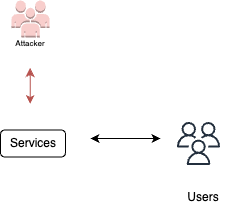
Creating service credentials in the context of DevOps refers to the process of generating and managing authentication credentials for services or applications used within the CI/CD pipeline or infrastructure. Service credentials provide secure access to various resources, such as cloud platforms, databases, or external APIs, and help establish trust and authorization between different components of the DevOps environment. Properly managing service credentials is crucial for maintaining the security and integrity of the DevOps pipeline and ensuring authorized access to sensitive resources.
Privilege escalation
Privilege escalation techniques in the context of DevOps refer to the methods used by an attacker to elevate their privileges within a victim’s environment. By gaining higher privileges, the attacker can access more sensitive resources, manipulate configurations, and potentially compromise the entire DevOps infrastructure. Understanding and mitigating privilege escalation risks is crucial to maintaining the security and integrity of the DevOps environment.
Secrets in private repositories
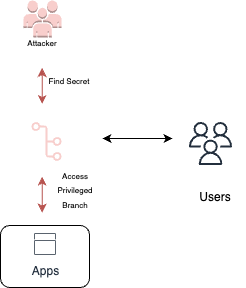
The presence of secrets in private repositories poses a significant security risk within the DevOps environment. Attackers who have gained initial access can leverage this access to scan private repositories in search of hidden secrets. Private repositories are typically considered more secure as they are inaccessible from outside the organization. However, if sensitive information such as API keys, passwords, or cryptographic keys are mistakenly committed or stored within these repositories, they can be exposed to unauthorized individuals. Detecting and mitigating the presence of secrets in private repositories is essential to maintain the confidentiality and integrity of the organization’s assets.
Commit/push to protected branches

Committing or pushing code to protected branches in a repository can pose a significant security risk in the DevOps environment. If the pipeline has access to the repository and the repository’s access controls are permissive, it may allow an attacker to bypass normal code review and approval processes and inject malicious code directly into important branches without the intervention of the development team. This can lead to unauthorized code execution, compromising the integrity and security of the application or system. Implementing proper access controls and review processes is crucial to mitigate the risk of unauthorized code changes in protected branches.
Certificates and identities from metadata services
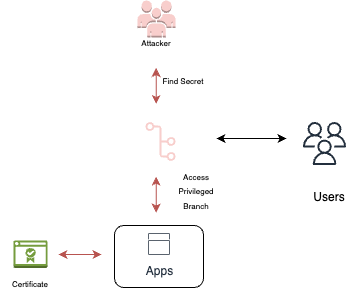
In cloud-hosted pipelines, attackers may exploit the access they already have to the environment to gain unauthorized access to certificates and identities stored in metadata services. These services, often provided by cloud platforms, store sensitive information such as certificates, authentication tokens, and identity-related data. Extracting such information allows the attacker to assume the privileges associated with those certificates or identities, potentially compromising the security and confidentiality of the DevOps environment. Protecting and securing certificates and identities from metadata services is crucial to prevent unauthorized access and maintain the integrity of the system.
Credential access
Credential access techniques refer to the methods used by attackers to steal credentials within the DevOps environment. By obtaining valid credentials, attackers can gain unauthorized access to critical systems, services, or resources. It is crucial to protect credentials and implement measures to prevent their unauthorized access or theft. Understanding and mitigating credential access risks is essential to maintain the security and integrity of the DevOps environment.
User credentials

User credentials are often required in CI pipelines to access external services such as databases, APIs, or other resources. However, if not properly secured, these credentials can become a target for attackers. They may try to gain access to the pipeline and extract the credentials to gain unauthorized access to external services. Protecting user credentials is crucial to prevent unauthorized access and maintain the security of the DevOps environment.
Service credentials
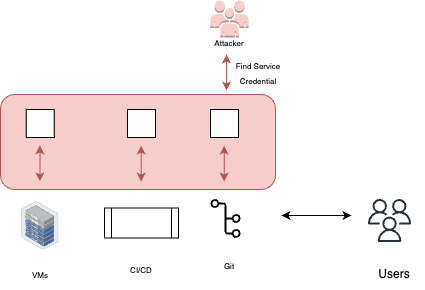
Service credentials, such as service principal names (SPN) and shared access signature (SAS) tokens, are commonly used in DevOps environments to authenticate and authorize access to various services and resources. However, if these credentials are compromised, an attacker can gain unauthorized access to other services directly from the pipeline. Protecting service credentials is essential to prevent unauthorized access and maintain the security of the DevOps environment.
Lateral movement
The lateral movement tactic in CI/CD environments refers to the techniques used by attackers to move through different resources within the DevOps pipeline. Attackers aim to gain access to deployment resources, build artifacts, registries, or other targets to expand their reach and carry out malicious activities. Detecting and preventing lateral movement is crucial to maintain the security and integrity of the CI/CD environment.
Compromise build artifacts
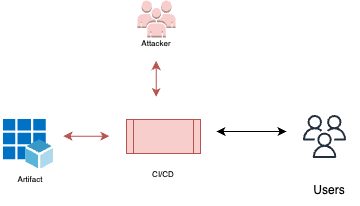
Compromising build artifacts is a supply chain attack where an attacker gains control over the CI pipelines and manipulates the build artifacts. By injecting malicious code into the building materials before the build process is completed, the attacker can introduce malicious functionality into the final build artifacts. Protecting build artifacts is essential to prevent the deployment of compromised or malicious software.
Registry injection
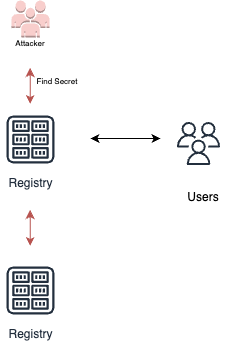
Registry injection is a technique where an attacker infects the registry used for storing build artifacts in a CI/CD pipeline. By injecting malicious images into the registry, the attacker aims to have these images downloaded and executed by containers that rely on the infected registry. Preventing registry injection is crucial to ensure the integrity and security of the build artifacts used in the CI/CD process.
Spread to deployment resources
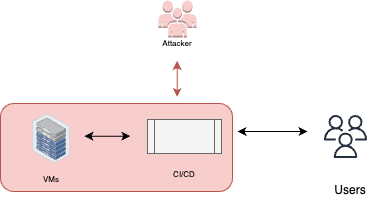
Spreading to deployment resources refers to the scenario where an attacker gains access to the deployment resources within a CI/CD pipeline. By leveraging the access granted to the pipeline, the attacker can propagate their presence to the deployment environment, leading to potential code execution, data exfiltration, and other malicious activities. Preventing the spread to deployment resources is crucial to maintain the security and integrity of the deployment environment.
Defense evasion
Defense evasion techniques are employed by attackers to bypass or evade the security measures and defenses implemented in a DevOps environment. By evading detection and mitigation mechanisms, attackers can continue their attacks undetected and maintain persistence within the environment. Understanding and mitigating these evasion techniques is crucial to ensure the security and resilience of a DevOps environment.
Service logs manipulation
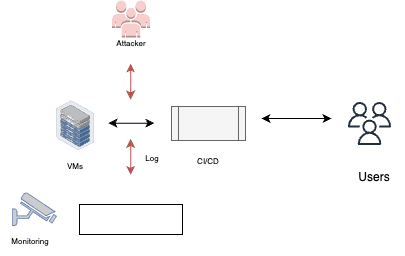
Service logs manipulation is a technique where an attacker, who has gained access to the environment, modifies the logs generated by various services. By tampering with the logs, the attacker aims to hide their activities and prevent defenders from detecting their presence or identifying the attacks they have executed. Detecting and preventing service logs manipulation is crucial for maintaining the integrity and reliability of log data for security analysis.
Compilation manipulation
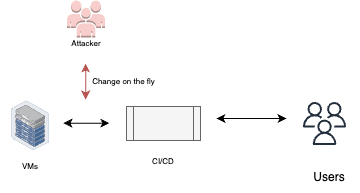
Compilation manipulation is a technique used by attackers to inject malicious code into the compilation process, which can result in the inclusion of backdoors or vulnerabilities in the final software build. By tampering with the compilation process, the attacker aims to evade detection and introduce malicious functionality into the software without leaving obvious traces in the source code or version control system.
Reconfigure branch protections

Reconfiguring branch protections is a technique where an attacker with administrative permissions modifies the configuration settings of branch protection tools. By altering these settings, the attacker can bypass the controls and introduce code into a branch without the need for any user intervention or approval. This can enable the attacker to inject malicious code into the codebase and potentially compromise the integrity of the repository.
Impact
The impact tactic refers to techniques used by attackers to exploit access to CI/CD resources for malicious purposes. Unlike other tactics, these techniques are not intended to be stealthy or covert, but rather to cause immediate and noticeable damage or disruption to the organization’s CI/CD pipelines and resources. These techniques can have a significant impact on the availability, integrity, and confidentiality of the software development and deployment processes.
DDoS

DDoS (Distributed Denial of Service) is a type of attack where an adversary overwhelms a target system or network with a flood of traffic from multiple sources, causing service disruptions or outages. In a CI/CD environment, an attacker with access to compute resources can misuse them to launch DDoS attacks against external targets.
Cryptocurrency mining
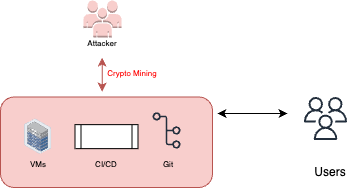
Cryptocurrency mining is the process of using computational resources to solve complex mathematical problems and earn cryptocurrency rewards. In a compromised CI/CD environment, an attacker may utilize the compute resources for unauthorized cryptocurrency mining, consuming system resources and potentially causing performance degradation.
Local DoS

Local Denial of Service (DoS) attacks are performed by an attacker who has gained access to the CI pipelines. The attacker uses the pipelines to launch DoS attacks against the organization’s own infrastructure or services, causing disruptions or overloading the virtual machines (VMs) used in the CI/CD environment.
Resource deletion

Resource deletion is a technique used by attackers who have gained access to CI/CD resources to cause denial of service by permanently deleting critical resources, such as cloud resources or repositories. By deleting these resources, the attacker disrupts the organization’s operations and prevents normal functioning of the CI/CD environment.
Exfiltration
The exfiltration tactic involves various techniques used by attackers to extract sensitive data from a victim’s environment in a CI/CD context. These techniques aim to bypass security controls and transfer data outside the organization’s network or infrastructure.
Clone private repositories
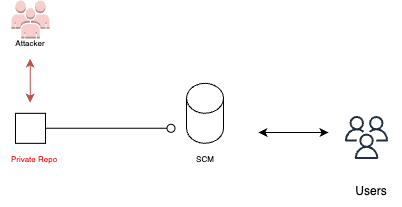
In this scenario, the attacker leverages their access to the CI pipelines to clone private repositories, giving them access to sensitive code and potentially valuable intellectual property. They exploit the permissions and tokens available within the CI environment, such as GITHUB_TOKEN in GitHub, to clone private repositories.
Pipeline logs

In this scenario, the attacker exploits their access to the CI/CD pipelines to access and view the pipeline execution logs. These logs often contain valuable information about the build process, deployment details, and potentially sensitive data such as credentials to services and user accounts.
Exfiltrate data from production resources
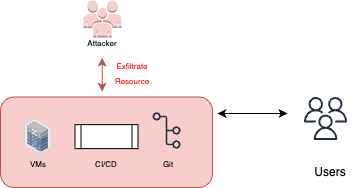
In this scenario, the attacker exploits their access to the CI/CD pipelines, which also have access to production resources. This allows the attacker to exfiltrate sensitive data from the production environment using the pipeline as a means of transportation.
Kubernetes Threat Matrix
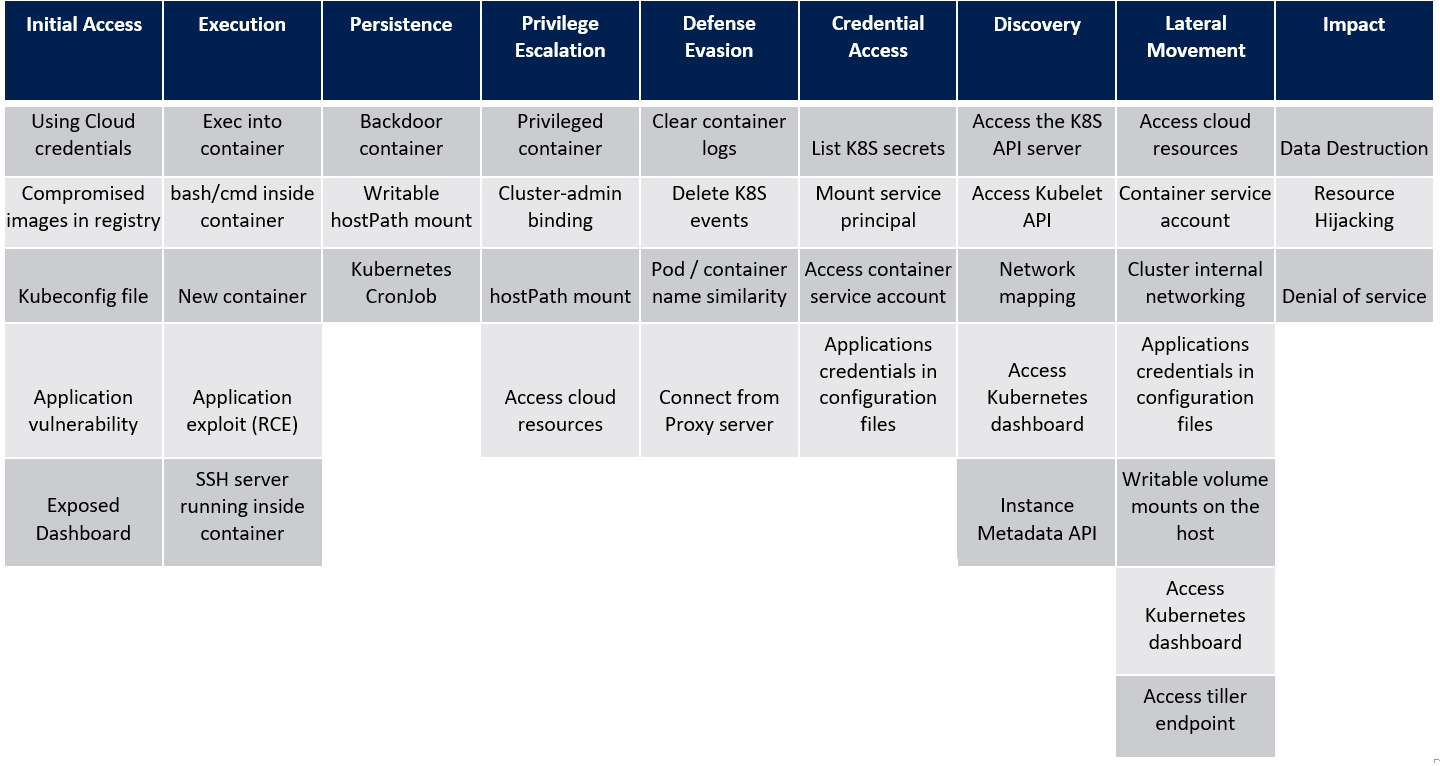
The Threat Matrix highlights various attack techniques, including both known and hypothetical scenarios, that could be exploited by adversaries targeting Kubernetes environments. It categorizes these techniques into different stages of the attack lifecycle, such as initial access, privilege escalation, lateral movement, persistence, and exfiltration.
Initial access
As organizations embrace containerized environments like Kubernetes, it becomes essential to understand the potential vulnerabilities and attack vectors that adversaries may exploit. The initial access tactic poses a significant threat, serving as the entry point for unauthorized actors into Kubernetes clusters. In this article, we will explore some common techniques used to gain initial access and discuss proactive measures to secure your Kubernetes environment.
Using cloud credentials
In cloud-based Kubernetes deployments, compromised cloud credentials can spell disaster. Attackers who gain access to cloud account credentials can infiltrate the cluster’s management layer, potentially leading to complete cluster takeover. It is crucial to implement robust cloud security practices, such as strong access controls and multi-factor authentication, to safeguard against unauthorized access to cloud credentials.
Compromised images in registry
Running compromised container images within a cluster can introduce significant risks. Attackers with access to a private registry can inject their own compromised images, which can then be inadvertently pulled by users. Additionally, using untrusted images from public registries without proper validation can expose the cluster to malicious content. Employing image scanning and verifying the trustworthiness of container images can help mitigate this risk.
Kubeconfig file
The kubeconfig file, which contains cluster details and credentials, is used by Kubernetes clients like kubectl. If an attacker gains access to this file, they can exploit it to gain unauthorized access to the Kubernetes clusters. Securing the kubeconfig file through secure distribution channels, enforcing access controls, and employing secure client environments are essential steps to mitigate this risk.
Vulnerable application
Running a vulnerable application within a cluster can open the door to initial access. Exploiting remote code execution vulnerabilities in containers can allow attackers to execute arbitrary code. If a service account is mounted to the compromised container, the attacker can use its credentials to send requests to the Kubernetes API server. Regularly patching and updating container images, along with implementing strong network segmentation, are crucial to mitigating this risk.
Exposed dashboard
The Kubernetes dashboard, when exposed externally without proper authentication and access controls, becomes a potential entry point for unauthorized access. Attackers can exploit an exposed dashboard to gain remote management capabilities over the cluster. It is essential to restrict access to the dashboard, enable authentication, and ensure it is accessible only through secure connections.
Execution
Once attackers gain initial access to a Kubernetes cluster, the execution tactic becomes their next focus. By leveraging various techniques, attackers attempt to run their malicious code within the cluster, potentially causing widespread damage. In this article, we will explore common execution techniques in Kubernetes and discuss key strategies to mitigate the associated risks.
Exec into container:
Attackers with sufficient permissions can exploit the “exec” command (“kubectl exec”) to run malicious commands inside containers within the cluster. By using legitimate images, such as popular OS images, as a backdoor container, attackers can remotely execute their malicious code through “kubectl exec.” Limiting permissions and enforcing strict access controls will help prevent unauthorized execution within containers.
New container:
Attackers with permissions to deploy pods or controllers, like DaemonSets, ReplicaSets, or Deployments, may attempt to create new resources within the cluster for running their code. It is crucial to regularly audit and review access controls, ensuring that only authorized entities can create and deploy containers. Monitoring the creation of new resources and implementing least privilege principles will limit unauthorized code execution.
Application exploit:
Exploiting vulnerabilities in applications deployed within the cluster presents an opportunity for attackers to execute their code. Vulnerabilities that allow remote code execution or enable unauthorized access to resources can be leveraged. Mounting service accounts to containers, which is the default behavior in Kubernetes, may grant attackers the ability to send requests to the API server using compromised service account credentials. Regular patching and vulnerability management are crucial to mitigating this risk.
SSH server running inside container:
In some cases, attackers may discover containers running SSH servers. If attackers acquire valid credentials, either through brute-force attempts or phishing, they can exploit these SSH servers to gain remote access to the container. To mitigate this risk, it is essential to employ strong authentication mechanisms, enforce secure credential management practices, and regularly audit containers for unauthorized SSH servers.
Persistence
In the context of Kubernetes security, persistence refers to the techniques employed by attackers to maintain access to a cluster even after their initial entry point has been compromised. By understanding and addressing the persistence tactics used by adversaries, organizations can strengthen their security posture and protect their Kubernetes environments. In this article, we will explore common persistence techniques in Kubernetes and discuss strategies to mitigate these risks.
Backdoor container:
One method attackers employ to establish persistence is by running malicious code within a container in the cluster. By leveraging Kubernetes controllers like DaemonSets or Deployments, attackers can ensure that a specific number of containers constantly run on one or more nodes in the cluster. To counter this, regular monitoring of controller configurations and thorough auditing of container images can help detect and remove unauthorized backdoor containers.
Writable hostPath mount:
The hostPath volume allows mounting a directory or file from the host to a container. Attackers with permissions to create containers within the cluster can exploit this feature by creating a container with a writable hostPath volume. This provides them with persistence on the underlying host and potential avenues for unauthorized access. Implementing strict access controls and regular auditing of container configurations can help identify and mitigate this risk.
Kubernetes CronJob:
Kubernetes CronJob is a scheduling mechanism used to run Jobs at specified intervals. Attackers may leverage Kubernetes CronJob functionality to schedule the execution of malicious code as a container within the cluster. This allows them to maintain persistence by regularly running their code. Monitoring and reviewing CronJob configurations, as well as conducting periodic vulnerability scans, are crucial in identifying and addressing any unauthorized or suspicious CronJobs.
Privilege escalation
Privilege escalation is a critical tactic employed by attackers to gain higher privileges within a Kubernetes environment. By obtaining elevated access, attackers can potentially compromise the entire cluster, breach cloud resources, and disrupt critical operations. Understanding common privilege escalation techniques is crucial for implementing effective security measures. In this article, we will explore common privilege escalation techniques in Kubernetes and discuss strategies to mitigate these risks.
Privileged container
A privileged container possesses all the capabilities of the host machine, allowing unrestricted actions within the cluster. Attackers who gain access to a privileged container, or have permissions to create one, can exploit the host’s resources. It is essential to enforce strict container security policies, limit the creation of privileged containers, and regularly monitor for unauthorized access or configuration changes.
Cluster-admin binding
Role-based access control (RBAC) is a fundamental security feature in Kubernetes, controlling the actions of different identities within the cluster. Cluster-admin is a built-in high-privileged role in Kubernetes. Attackers with permissions to create bindings and cluster-bindings can create a binding to the cluster-admin ClusterRole or other high-privileged roles. Implementing least privilege principles, regularly reviewing RBAC configurations, and conducting frequent audits are vital for preventing unauthorized privilege escalation.
hostPath mount
Attackers can leverage the hostPath volume mount to gain access to the underlying host, breaking out of the container’s isolated environment. This allows them to escalate privileges from the container to the host. Implementing strict access controls, conducting regular vulnerability scans, and monitoring for suspicious hostPath mount configurations are essential for mitigating this risk.
Accessing cloud resources:
In cloud-based Kubernetes deployments, attackers may leverage their access to a single container to gain unauthorized access to other cloud resources outside the cluster. For instance, in Azure Kubernetes Service (AKS), each node contains a service principal credential used for managing Azure resources. Attackers who gain access to this credential file can exploit it to access or modify cloud resources. Strictly managing access to service principal credentials, encrypting sensitive files, and regularly rotating credentials are critical mitigation steps.
Defense evasion
Defense evasion techniques are employed by attackers to evade detection and conceal their activities within Kubernetes environments. By actively evading security measures, attackers can prolong their presence, increase the likelihood of successful attacks, and bypass traditional security controls. Understanding common defense evasion techniques is crucial for organizations to enhance threat detection capabilities and bolster overall Kubernetes security. In this article, we will explore common defense evasion tactics and discuss strategies to mitigate these risks effectively.
Clear container logs:
Attackers may attempt to delete application or operating system logs on compromised containers to conceal their malicious activities. Organizations should implement robust log management practices, including centralizing logs and establishing secure backup mechanisms. Regularly monitoring log files for suspicious activities and implementing access controls to prevent unauthorized log modifications are vital to maintain visibility into container activities.
Delete Kubernetes events:
Kubernetes events play a critical role in logging state changes and failures within the cluster. Attackers may seek to delete Kubernetes events to avoid detection of their activities. Organizations should ensure proper event logging and implement log integrity checks to detect any tampering or deletion of events. Retaining logs in a secure and immutable manner can aid in the identification of anomalous behavior.
Pod/container name similarity:
Attackers may attempt to hide their malicious activities by naming their backdoor pods in a way that resembles legitimate pods created by controllers like Deployments or DaemonSets. By blending in with existing pod naming conventions, attackers aim to avoid suspicion. Organizations should implement strict naming conventions and conduct regular audits to identify any discrepancies or suspicious pod/container names.
Connect from proxy server
To obfuscate their origin IP addresses, attackers may employ proxy servers, including anonymous networks like TOR, to communicate with applications or the Kubernetes API server. Organizations should consider implementing network security measures to monitor and restrict access from suspicious IP ranges or anonymous networks. Implementing intrusion detection and prevention systems (IDPS) and conducting regular threat intelligence analysis can aid in identifying proxy server usage by attackers.
Credential access
The security of credentials is of paramount importance in Kubernetes environments. Attackers employ various techniques to steal credentials, including application credentials, service accounts, secrets, and cloud credentials. Safeguarding credential access is crucial to prevent unauthorized access, data breaches, and potential compromise of sensitive information. In this article, we will explore common credential access tactics and discuss strategies to enhance identity protection and mitigate the risks associated with credential theft in Kubernetes.
List Kubernetes secrets:
Kubernetes secrets are used to store sensitive information, such as passwords and connection strings, within the cluster. Attackers with appropriate permissions can retrieve these secrets from the API server, potentially gaining access to critical credentials. Organizations should adopt a defense-in-depth approach to secure secrets, including strong access controls, encryption, and regular auditing of secret configurations. Implementing fine-grained RBAC policies and limiting access to secrets based on the principle of least privilege can help mitigate the risk of unauthorized access.
Mount service principal:
In cloud deployments, attackers may exploit their access to a container in the cluster to gain unauthorized access to cloud credentials. For example, in Azure Kubernetes Service (AKS), each node contains a service principal credential. Organizations should implement robust security measures, such as secure cluster configurations, strict access controls, and regular rotation of service principal credentials, to prevent unauthorized access to cloud resources.
Access container service account:
Service accounts (SAs) are used to represent application identities within Kubernetes. By default, SAs are mounted to every pod in the cluster, allowing containers to interact with the Kubernetes API server. Attackers who gain access to a pod can extract the SA token and potentially perform actions within the cluster based on the SA’s permissions. It is crucial to implement RBAC and enforce strong authentication mechanisms to mitigate the risk of unauthorized SA access. Regular audits and monitoring of SA permissions can help identify and remediate any potential security gaps.
Application credentials in configuration files:
Developers often store secrets, such as application credentials, in Kubernetes configuration files, including environment variables in the pod configuration. Attackers may attempt to access these configuration files to steal sensitive information. Organizations should promote secure coding practices, such as externalizing secrets to a secure secret management solution, and avoid storing credentials directly in configuration files. Implementing secure coding guidelines, regular security training for developers, and automated vulnerability scanning can help reduce the risk of unauthorized access to application credentials.
Discovery
Discovery attacks pose a significant threat to the security of Kubernetes environments. Attackers employ various techniques to explore the environment, gain insights into the cluster’s resources, and perform lateral movement to access additional targets. Understanding and mitigating these discovery tactics is crucial to bolster the overall security posture of Kubernetes deployments. In this article, we will delve into common discovery techniques and discuss strategies to enhance defense and thwart unauthorized exploration in Kubernetes.
Access the Kubernetes API server:
The Kubernetes API server acts as the gateway to the cluster, enabling interactions and resource management. Attackers may attempt to access the API server to gather information about containers, secrets, and other resources. Protecting the API server is paramount, and organizations should implement strong authentication mechanisms, robust access controls, and secure communication channels (TLS) to prevent unauthorized access and unauthorized retrieval of sensitive data.
Access Kubelet API:
Kubelet, running on each node, manages the execution of pods and exposes a read-only API service. Attackers with network access to the host can probe the Kubelet API to gather information about running pods and the node itself. To mitigate this risk, organizations should implement network segmentation and restrict network access to the Kubelet API, employing firewalls or network policies to allow communication only from trusted sources.
Network mapping:
Attackers may attempt to map the cluster network to gain insights into running applications and identify potential vulnerabilities. Implementing network segmentation, network policies, and utilizing network security solutions can help limit unauthorized network exploration within the cluster, reducing the attack surface and minimizing the impact of network mapping attempts.
Access Kubernetes dashboard:
The Kubernetes dashboard provides a web-based interface for managing and monitoring the cluster. Attackers who gain access to a container in the cluster may attempt to exploit the container’s network access to access the dashboard pod. Organizations should secure the Kubernetes dashboard by implementing strong authentication, role-based access controls (RBAC), and secure network access policies to prevent unauthorized access and information leakage.
Instance Metadata API:
Cloud providers offer instance metadata services that provide information about virtual machine configurations and network details. Attackers who compromise a container may attempt to query the instance metadata API to gain insights into the underlying node. Protecting the metadata API is crucial, and organizations should implement network-level security controls, such as restricting access to the metadata service from within the VM only, to prevent unauthorized access and limit the exposure of sensitive information.
Lateral movement
Lateral movement attacks pose a significant threat in containerized environments, allowing attackers to traverse through a victim’s environment, gain unauthorized access to various resources, and potentially escalate privileges. Understanding and mitigating lateral movement tactics is crucial for bolstering the security of Kubernetes deployments. In this article, we will explore common techniques used by attackers for lateral movement and discuss strategies to enhance defense and minimize the impact of these attacks in Kubernetes.
Access the Kubernetes API server:
The Kubernetes API server acts as the gateway to the cluster, enabling interactions and resource management. Attackers may attempt to access the API server to gather information about containers, secrets, and other resources. Protecting the API server is paramount, and organizations should implement strong authentication mechanisms, robust access controls, and secure communication channels (TLS) to prevent unauthorized access and unauthorized retrieval of sensitive data.
Access Cloud Resources:
Attackers who compromise a container in the cluster may attempt to move laterally into the cloud environment itself. Organizations must implement strong access controls, employ least privilege principles, and regularly monitor cloud resources to detect and prevent unauthorized access attempts.
Container Service Account:
Attackers with access to a compromised container can leverage the mounted service account token to send requests to the Kubernetes API server and gain access to additional resources within the cluster. Securing container service accounts through RBAC and regularly rotating credentials can help mitigate the risk of lateral movement through compromised containers.
Cluster Internal Networking:
By default, Kubernetes allows communication between pods within the cluster. Attackers who gain access to a single container can leverage this networking behavior to traverse the cluster and target additional resources. Implementing network segmentation, network policies, and regular network monitoring can restrict unauthorized lateral movement within the cluster.
Application Credentials in Configuration Files:
Developers often store sensitive credentials in Kubernetes configuration files, such as environment variables in pod configurations. Attackers who gain access to these credentials can use them to move laterally and access additional resources both inside and outside the cluster. Employing secure secrets management practices, such as encrypting configuration files and limiting access to sensitive information, can mitigate the risk of credential-based lateral movement.
Writable Volume Mounts on the Host:
Attackers may attempt to exploit writable volume mounts within a compromised container to gain access to the underlying host. Securing host-level access controls, implementing strong container isolation, and regularly patching and hardening the underlying host can help mitigate the risk of lateral movement from containers to the host.
Access Kubernetes Dashboard:
Attackers with access to the Kubernetes dashboard can manipulate cluster resources and execute code within containers using the built-in “exec” capability. Securing the Kubernetes dashboard through strong authentication, access controls, and monitoring for suspicious activities can minimize the risk of unauthorized lateral movement through the dashboard.
Access Tiller Endpoint:
Tiller, the server-side component of Helm, may expose internal gRPC endpoints that do not require authentication. Attackers who can access a container connected to the Tiller service may exploit this vulnerability to perform unauthorized actions within the cluster. Organizations should consider migrating to Helm version 3, which removes the Tiller component and eliminates this specific risk.
Impact
The Impact tactic in Kubernetes refers to techniques employed by attackers to disrupt, abuse, or destroy the normal behavior of the environment. These attacks can lead to data loss, resource abuse, and denial of service, resulting in severe consequences for organizations. Protecting Kubernetes deployments from such impact attacks is crucial to ensure the availability, integrity, and confidentiality of resources. In this article, we will explore common impact techniques used by attackers and discuss strategies to mitigate their effects in Kubernetes environments.
Data Destruction:
Attackers may target Kubernetes deployments to destroy critical data and resources. This can involve deleting deployments, configurations, storage volumes, or compute resources. To mitigate the risk of data destruction, it is essential to implement robust backup and disaster recovery mechanisms. Regularly backing up critical data, verifying backup integrity, and employing proper access controls can help in minimizing the impact of data destruction attacks.
Resource Hijacking:
Compromised resources within a Kubernetes cluster can be abused by attackers for malicious activities such as digital currency mining. Attackers who gain access to containers or have the permissions to create new containers may exploit these resources for unauthorized tasks. Implementing strict pod security policies, monitoring resource utilization, and regularly auditing containers for unauthorized activities can help detect and prevent resource hijacking attempts.
Denial of Service (DoS):
Attackers may launch DoS attacks to disrupt the availability of Kubernetes services. This can involve targeting containers, nodes, or the API server. To mitigate the impact of DoS attacks, it is crucial to implement network-level security measures such as ingress and egress filtering, rate limiting, and traffic monitoring. Additionally, implementing resource quotas, configuring horizontal pod autoscaling, and monitoring resource utilization can help in maintaining service availability and mitigating the impact of DoS attacks.
Cloud Threat Matrix
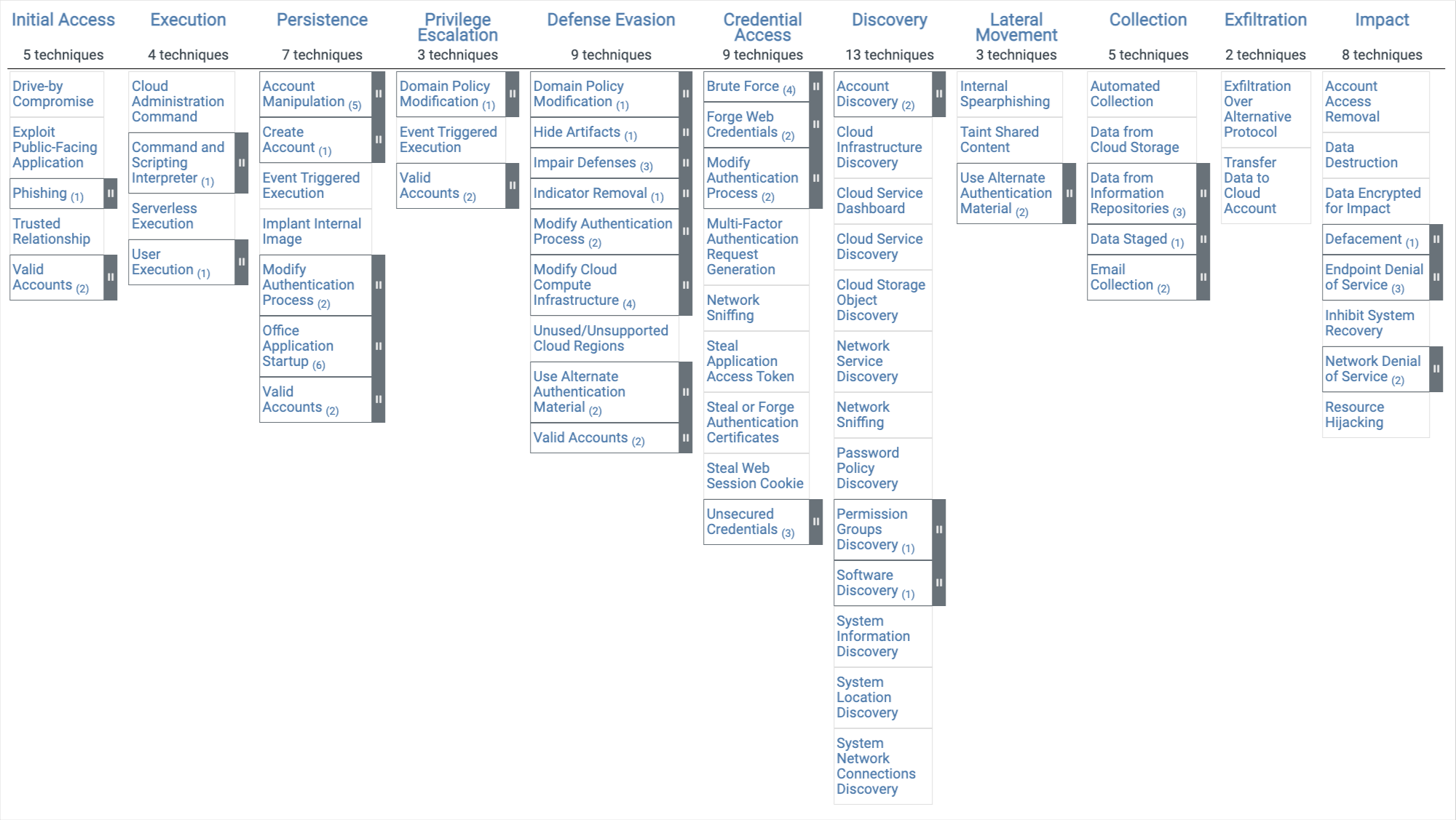
The MITRE ATT&CK framework provides a comprehensive knowledge base of adversary tactics and techniques used in cyber attacks.
Initial Access:
Cloud Account Phishing
An attacker attempts to gain unauthorized access to a cloud account through phishing techniques.
Cloud Service Exploitation
Attackers exploit vulnerabilities in cloud services to gain initial access.
Execution
Remote Execution
Attackers execute code or commands on a cloud system remotely.
User Execution
Attackers trick a user into executing malicious code or commands on a cloud system.
Persistence
Persistence through Cloud Resource
Access: Attackers establish persistence by maintaining access to cloud resources or accounts.
Persistence through Cloud Service
Attackers use cloud services or features to establish persistence in the environment.
Privilege Escalation
Access Cloud Service Permissions
Attackers escalate their privileges by manipulating cloud service permissions.
Container Escape
Attackers escape containerization to gain higher privileges in the cloud environment.
Defense Evasion
Clear Cloud Logs
Attackers attempt to delete or manipulate logs in the cloud environment to evade detection.
Modify Cloud Trail
Attackers modify or tamper with cloud trail logs to hide their activities.
Credential Access
Steal Cloud Service Credentials
Attackers steal cloud service credentials to gain unauthorized access.
Capture Cloud Service Credentials
Attackers capture cloud service credentials through various means.
Discovery
Cloud Service Discovery
Attackers discover cloud services and resources to gather information about the environment.
Container Discovery
Attackers identify and explore containers within the cloud environment.
Lateral Movement
Cloud Infrastructure Lateral Movement
Attackers move laterally between cloud resources and accounts.
Container-to-Container Lateral Movement
Attackers move laterally between containers within the cloud environment.
Collection
Data from Cloud Storage Object
Attackers collect and exfiltrate data from cloud storage objects.
Data from Container
Attackers collect and exfiltrate data from containers in the cloud environment.
Exfiltration:
Exfiltration Over Cloud Channel
Attackers exfiltrate data through cloud-based communication channels.
Exfiltration Over Other Network Medium
Attackers exfiltrate data using other network mediums within the cloud environment.
Threat Hunting
Shodan
A search engine for internet-connected devices that allows you to identify potential attack surfaces and vulnerabilities in your network.
shodan scan submit --filename scan.json "port:22"
VirusTotal
A threat intelligence platform that allows you to analyze files and URLs for potential threats and malware.
curl --request POST --url 'https://www.virustotal.com/api/v3/urls' --header 'x-apikey: YOUR_API_KEY' --header 'content-type: application/json' --data '{"url": "https://example.com"}'
ThreatConnect
A threat intelligence platform that allows you to collect, analyze, and share threat intelligence with your team and community.
curl -H "Content-Type: application/json" -X POST -d '{"name": "Example Threat Intel", "description": "This is an example threat intelligence report."}' https://api.threatconnect.com/api/v2/intelligence
MISP
An open-source threat intelligence platform that allows you to collect, store, and share threat intelligence with your team and community.
curl -X POST 'http://misp.local/events/restSearch' -H 'Authorization: YOUR_API_KEY' -H 'Content-Type: application/json' -d '{ "returnFormat": "json", "eventid": [1,2,3], "enforceWarninglist":0 }'
ChatGPT
Generate Yara Rule
- Specify the objective of the YARA rule. For this example, let’s create a rule to detect a specific type of malware based on its behavior.
Prompt: “Please provide a brief description of the malware behavior you want to detect.”
- Identify indicators of the malware, such as file names, strings, or patterns that are characteristic of the malware. This information will be used in the YARA rule.
Prompt: “What are some specific indicators or patterns associated with the malware?”
- Start the YARA rule by defining metadata such as the rule name, description, and author. Add this information to the rule.yar file.
Prompt: “Please provide the rule name, description, and author for the YARA rule.”
- Define the condition or logic that will trigger the rule when a match is found. Use the indicators identified in Step 2 and YARA syntax to specify the condition.
Prompt: “Please provide the condition for the YARA rule using the indicators and YARA syntax.”
- Optionally, add tags to the YARA rule to provide additional information or categorization. Tags can be used to group related rules together.
Prompt: “If applicable, please add any relevant tags to the YARA rule.”
- Test the YARA rule against sample files or known malware to ensure it detects the intended behavior.
Prompt: “Please test the YARA rule against sample files or known malware to verify its effectiveness.”
- Refine the YARA rule based on the test results and iterate on the steps as necessary to improve its accuracy and coverage.
Prompt: “Based on the test results, do you need to refine or iterate on the YARA rule?”
Code Analysis
- Acquire a malware sample that you want to analyze. This can be a file, script, or any other form of malicious code.
Prompt: “Please provide the malware sample you want to analyze.”
- Create a secure and isolated environment to analyze the malware sample. This can be a virtual machine, sandbox, or container.
Prompt: “How would you like to set up the secure environment? (e.g., virtual machine, sandbox)”
- Install the necessary tools for malware analysis. This typically includes disassemblers, debuggers, and code analysis tools.
Prompt: “Please list the specific tools you would like to install for malware code analysis.”
- Extract the malware from its container or packaging and inspect its components, such as executable files, scripts, or configuration files.
Prompt: “Please extract the malware sample and provide a brief overview of its components.”
- Use a disassembler or decompiler tool to analyze the malware’s code and convert it into a more readable format for analysis.
Prompt: “Which disassembler or decompiler tool would you like to use for the analysis?”
- Examine the code of the malware to identify its behavior, functions, and potential vulnerabilities. Look for any obfuscation techniques or anti-analysis measures used by the malware.
Prompt: “What specific aspects of the malware code would you like to analyze? (e.g., behavior, vulnerabilities)”
- If necessary, set up a debugger to trace the execution of the malware and understand its runtime behavior. This step may require advanced knowledge and specialized tools.
Prompt: “Do you want to debug and trace the execution of the malware? If yes, please specify the debugger tool.”
- Document your findings during the malware code analysis process, including identified behaviors, potential risks, and any other relevant information. Generate a report summarizing the analysis.
Prompt: “Please document your findings and generate a report summarizing the malware code analysis.”
- Based on the analysis, develop and apply security mitigations to protect against the malware’s attack vectors. This may involve patching vulnerabilities, updating security measures, or implementing specific controls.
Prompt: “What security mitigations would you recommend based on the analysis?”
Generate Script
- Acquire a malware sample that you want to analyze. This can be a file, script, or any other form of malicious code.
Prompt: “Please provide the malware sample you want to analyze.”
- Extract the malware from its container or packaging and inspect its components, such as executable files, scripts, or configuration files.
Prompt: “Please extract the malware sample and provide a brief overview of its components.”
- Examine the code of the malware to identify its behavior, functions, and potential vulnerabilities. Look for any obfuscation techniques or anti-analysis measures used by the malware.
Prompt: “What specific aspects of the malware code would you like to analyze? (e.g., behavior, vulnerabilities)”
- If necessary, set up a debugger to trace the execution of the malware and understand its runtime behavior. This step may require advanced knowledge and specialized tools.
Prompt: “Do you want to debug and trace the execution of the malware? If yes, please specify the debugger tool.”
- Document your findings during the malware code analysis process, including identified behaviors, potential risks, and any other relevant information. Generate a report summarizing the analysis.
Prompt: “Please document your findings and generate a report summarizing the malware code analysis.”
- Based on the analysis, develop and apply security mitigations to protect against the malware’s attack vectors. This may involve patching vulnerabilities, updating security measures, or implementing specific controls.
Prompt: “What security mitigations would you recommend based on the analysis?”
Log Analysis
- Preprocess the log files to extract the necessary information and make them more readable. Use tools like awk, sed, or grep to filter and format the log data. For example:
$ awk '{print $4, $7}' access.log > formatted_logs.txt
- Start by exploring the log data to understand its structure and content. Use commands like head, tail, or cat to view the log files. For example:
$ head formatted_logs.txt
Prompt: “Please provide a brief overview of the log data structure and format.”
- Perform statistical analysis on the log data to gain insights. Use tools like grep, sort, or uniq to extract useful information. For example:
$ grep '404' formatted_logs.txt | wc -l
Prompt: “Can you provide the count of HTTP 404 errors in the log data?”
- Apply pattern matching techniques to identify specific events or anomalies. Use commands like grep or regular expressions to search for patterns. For example:
$ grep -E '(\b\d{3}\b){4}' formatted_logs.txt
Prompt: “Please identify any IP addresses in the log data.”
- Perform time-based analysis to identify trends or suspicious activities. Use commands like awk or date to manipulate timestamps. For example:
$ awk '{print $4, $7}' access.log > formatted_logs.txt
Prompt: “Can you provide a distribution of log events based on the hour of the day?”
Engage in an interactive investigation by asking questions or seeking specific information. Use prompts like:
- “Can you identify any failed login attempts in the log data?”
- “Please provide the top 10 most accessed URLs in the log data.”
“Are there any user-agents associated with suspicious activities?”
- Create visualizations to present the findings. Use tools like matplotlib, gnuplot, or online visualization platforms. For example:
import matplotlib.pyplot as plt
# Code to generate a bar chart or line graph based on the log analysis results
Prompt: “Can you create a bar chart showing the distribution of log events over time?”
Databases
- https://otx.alienvault.com/
- https://exchange.xforce.ibmcloud.com/
- https://github.com/certtools/intelmq-feeds-documentation
- https://sca.analysiscenter.veracode.com/vulnerability-database/search#
- https://vulmon.com
- https://github.com/advisories
Playbook
- https://gitlab.com/syntax-ir/playbooks
Log
- https://github.com/logpai/loghub/tree/master
References
- https://socradar.io
